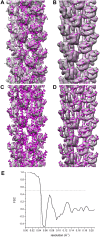Ambiguities in helical reconstruction
- PMID: 25486515
- PMCID: PMC4371874
- DOI: 10.7554/eLife.04969
Ambiguities in helical reconstruction
Abstract
Helical polymers are found throughout biology and account for a substantial fraction of the protein in a cell. These filaments are very attractive for three-dimensional reconstruction from electron micrographs due to the fact that projections of these filaments show many different views of identical subunits in identical environments. However, ambiguities exist in defining the symmetry of a helical filament when one has limited resolution, and mistakes can be made. Until one reaches a near-atomic level of resolution, there are not necessarily reality-checks that can distinguish between correct and incorrect solutions. A recent paper in eLife (Xu et al., 2014) almost certainly imposed an incorrect helical symmetry and this can be seen using filament images posted by Xu et al. A comparison between the atomic model proposed and the published three-dimensional reconstruction should have suggested that an incorrect solution was found.
Keywords: biophysics; cryo-EM; helical symmetry; human; structural biology; three-dimensional reconstruction.
Conflict of interest statement
The author declares that no competing interests exist.
Figures





Comment in
- doi: 10.7554/eLife.01489
References
Publication types
MeSH terms
Substances
Grants and funding
LinkOut - more resources
Full Text Sources
Other Literature Sources

